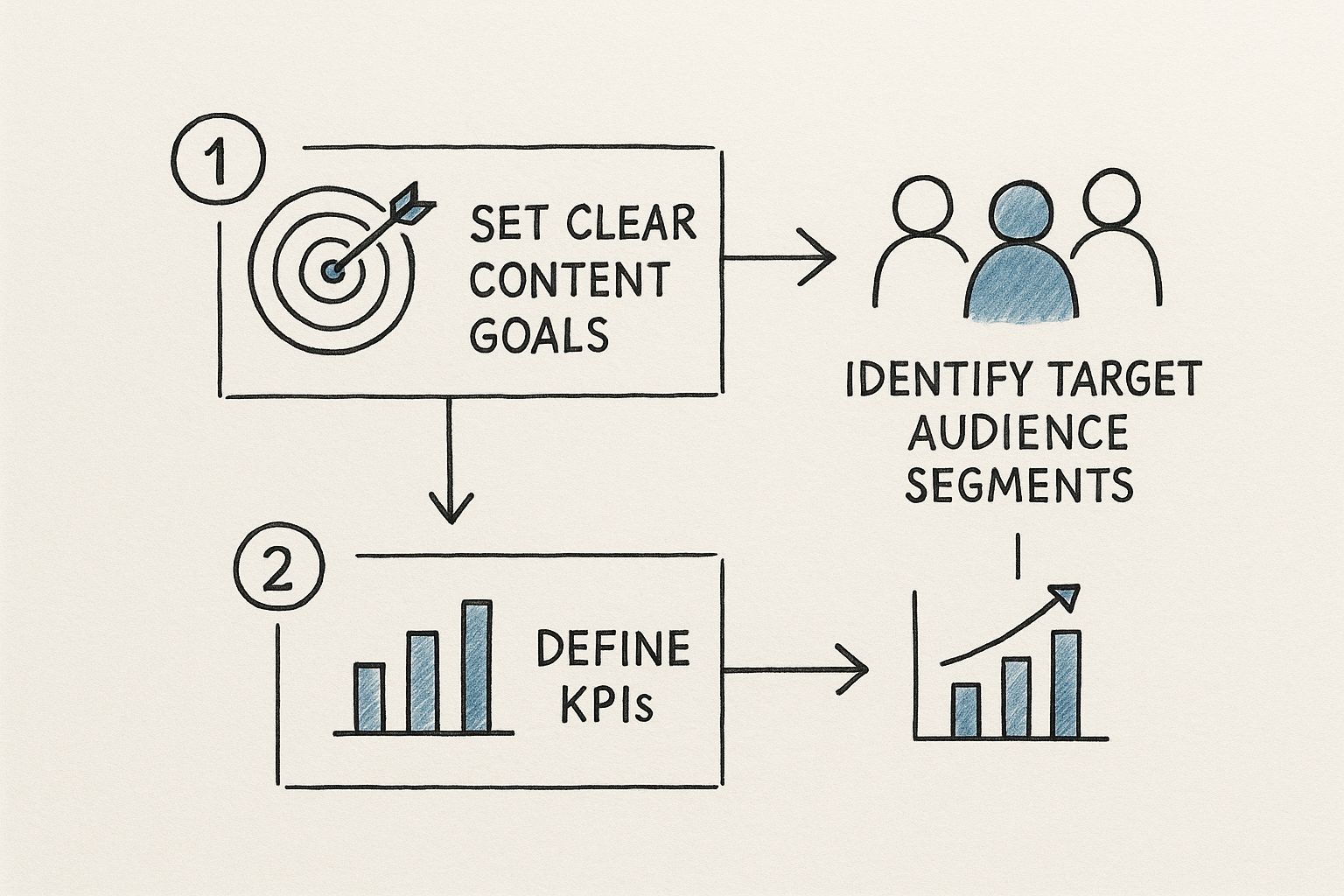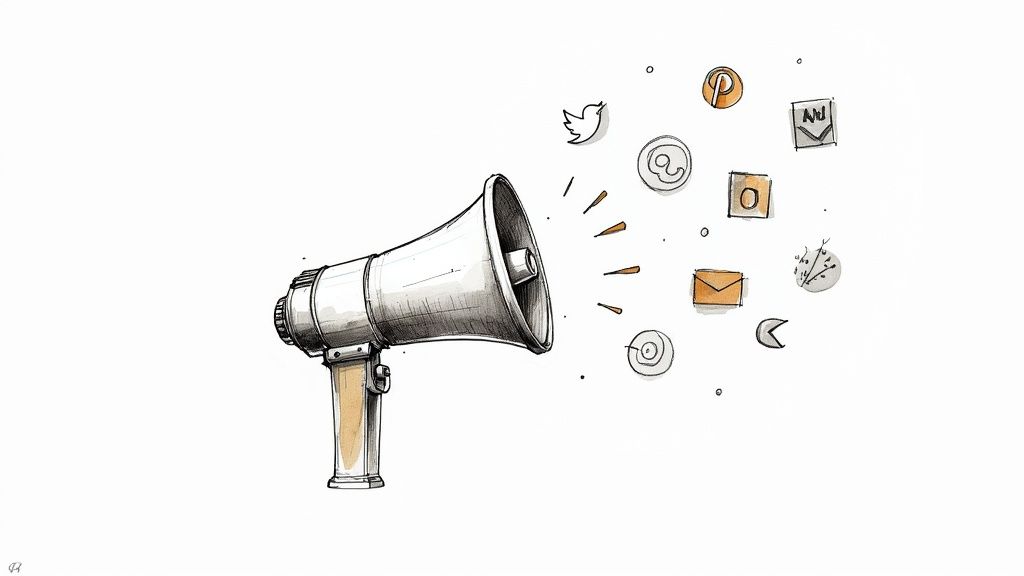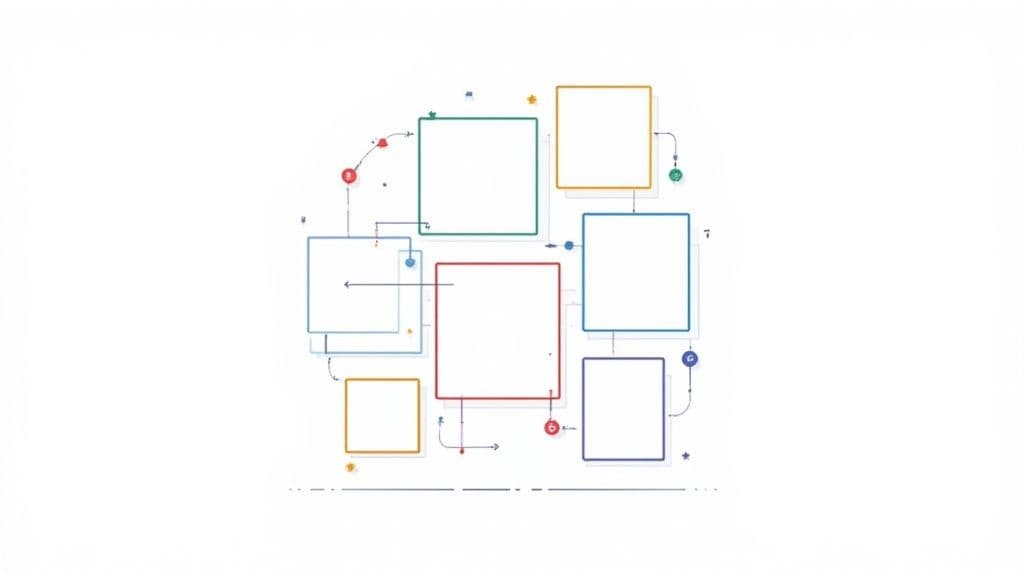Think of a content creation workflow as your team’s playbook. It’s the difference between a well-oiled machine and a last-minute scramble to get content out the door. Without one, you're basically winging it, and that’s a recipe for stress and inconsistent results. A good workflow turns chaos into a predictable, efficient process.
Why Your Team Needs a Content Creation Workflow
Let's get real for a moment. Creating content without a plan is a nightmare. A solid workflow is what holds your marketing team together, making sure everyone knows their role, what’s on their plate, and what’s coming up next. It’s what elevates content production from a frantic, reactive task to a strategic part of your business.
Ultimately, building a great workflow is all about finding smart ways to streamline business processes, which naturally leads to getting more done with less friction. This isn't just about ticking boxes on a to-do list; it's about building an environment where your team can actually be creative without getting bogged down by disorganization.
The Benefits of a Structured Approach
When you get your workflow right, the benefits are huge and go way beyond just being tidy. Teams with a clear process are often happier because there's less confusion and fewer "everything is on fire" moments.
Here are some of the biggest wins:
- Improved Consistency: Your content always looks and sounds like it came from your brand, maintaining a consistent voice and quality everywhere.
- Enhanced Efficiency: You can finally kill those bottlenecks and stop doing the same work twice because every step and responsibility is crystal clear.
- Better Collaboration: It creates one central hub for everything, making it so much easier for writers, designers, and managers to work together.
- Greater Scalability: A set process means you can ramp up your content production without everything falling apart.
This isn't just a "nice-to-have" anymore. With the global digital content creation market expected to grow at a compound annual growth rate of 12.8% over the next ten years, having a system is essential to keep up.
The 5 Core Phases of a Content Workflow
Every solid content workflow, whether you're a team of two or two hundred, is built on the same fundamental stages. Getting a handle on these is your first step toward building a process that works for you. It all starts with a clear strategy, not just jumping into creation.
This diagram perfectly illustrates the starting point: setting goals, knowing who you're talking to, and figuring out how you'll know if you've succeeded.

As you can see, a successful workflow always kicks off with strategy. This ensures every blog post, video, or social media update has a clear purpose from the get-go. It’s a system that moves logically from one stage to the next, building momentum along the way.
A great content workflow acts as your team's foundational operating system. It’s not about restricting creativity but about creating a stable structure where creativity can flourish without being hindered by logistical chaos.
Now, let's break down the entire journey into five core phases. Here’s a quick look at the five essential stages in any effective content workflow, outlining what you need to achieve in each phase.
The 5 Core Phases of a Content Workflow
| Phase | Primary Goal | Key Activities |
|---|---|---|
| 1. Planning | Define the "why" and "what" | Brainstorming ideas, keyword research, setting goals, outlining calendars. |
| 2. Creating | Bring the ideas to life | Writing copy, designing visuals, shooting video, recording audio. |
| 3. Reviewing | Polish and perfect the content | Editing, proofreading, fact-checking, getting approvals from stakeholders. |
| 4. Distributing | Get the content in front of the right people | Publishing on your site, scheduling social posts, running email campaigns. |
| 5. Analyzing | Measure what worked and what didn't | Tracking views and engagement, measuring KPIs, gathering insights for next time. |
By understanding and defining these five phases, you're creating a repeatable system that not only saves time but also consistently produces better content. Each stage feeds into the next, creating a powerful cycle of creation and improvement.
Laying the Groundwork with Strategic Planning

Look, great content doesn't just happen. The magic really begins long before you write a single word or pick out an image. This planning stage is where you turn big-picture business goals into a real, actionable content plan. Honestly, it's the most important part of any solid content creation workflow, as it steers everything else you do.
If you skip this strategic foundation, you're just throwing content at the wall to see what sticks. I've seen it happen countless times—it's a huge waste of time and money. Proper planning gives every single piece of content a purpose.
Getting to Know Your Audience for Real
First things first: you have to move past generic "buyer personas" and dig into the real-world struggles of your audience. What are their actual pain points? Their goals? What words do they use to talk about their problems? Guessing here is a recipe for content that nobody reads.
Instead, you need to get your hands on direct feedback. It's easier than you think.
- Dive into support tickets: What questions and frustrations pop up again and again?
- Run quick surveys: Ask your email list or social followers about their biggest challenges in your niche.
- Be a fly on the wall: Hang out in the Reddit threads, Facebook groups, or forums where your audience lives. Just listen to their conversations.
A B2B software company I know did this and had a huge breakthrough. They realized their audience wasn't searching for "financial automation software." They were typing in "how to stop spending hours on monthly reports." That kind of insight is pure gold. It completely changes your topics, your headlines, and your keywords.
Brainstorming Topics That Actually Hit the Mark
Once you truly understand what your audience needs, it's time to connect the dots. This means smart keyword research mixed with some creative brainstorming. The goal is to find that sweet spot between what people are searching for and what your brand knows best.
A classic mistake I see is teams chasing keywords with huge search volumes but ignoring the intent behind them. A winning plan answers the questions people are asking, which is how you build real authority.
Let's go back to that B2B software company. Their research might uncover a group of related phrases like "automating financial reports," "small business accounting errors," and "faster month-end closing." Suddenly, you have a clear theme to build your content around.
From there, you can plan different types of content to explore this theme from various angles, all managed neatly within a tool like Postiz.
Example Content Plan: Automating Financial Reports
| Content Type | Specific Topic Idea | Main Goal |
|---|---|---|
| Blog Post | "5 Common Errors in Financial Reports You Can Automate Away" | Attract organic traffic from search engines. |
| Social Media | Short video clips showing a "before and after" of manual vs. automated reporting. | Grab attention and boost engagement. |
| Webinar | "Live Demo: Cut Your Month-End Reporting Time by 50% with Postiz" | Generate high-quality leads and show off the product. |
| Infographic | "The True Cost of Manual Data Entry in Accounting" | Create a shareable asset for social media and outreach. |
This multi-format strategy lets you meet different people where they are, with content that fits their preferences. Every piece works together, strengthening your core message and guiding people along their journey.
Building Your Content Calendar Command Center
A content calendar should be so much more than a list of publish dates. Think of it as your strategic command center—the one document in your content creation workflow that keeps the whole team on the same page. It aligns writers, designers, and managers on goals, deadlines, and who's responsible for what.
When you use a platform like Postiz, your calendar becomes a dynamic, living hub. You can map out entire themes for the quarter, delegate tasks, set up review deadlines, and see the status of every single content piece at a glance, from "just an idea" to "published."
This centralized view stops the endless "what's the status of that blog post?" emails and Slack messages. Everyone knows what they need to do and when, which makes for a smooth, predictable process. That kind of organization is what separates the top-performing content teams from the ones who are always putting out fires.
From Drafts to Designs: The Creative Process
This is where the magic happens. All that careful planning turns into real, tangible content your audience can actually see and interact with. The creation phase is all about taking those strategic outlines and building them into well-written drafts and visuals that stop the scroll. It’s a delicate balance of quality and speed, making sure every post is polished and ready on time.
The whole thing kicks off when a writer grabs an assignment from your content calendar. Their first move isn't to start typing; it's to dive deep into the brief. They need to get inside the head of the target audience, understand their problems, and know exactly what message we’re trying to send before a single word is written.
From there, it’s all about crafting clear, persuasive copy that feels like a one-on-one conversation with the reader. This isn't just about hitting a word count. It's about telling a story that hooks people from the first sentence and guides them all the way to the end.
Getting Your Team in Sync
We’ve all been there—the chaos of endless email chains, random Slack DMs, and a mess of different file-sharing links. That's where a central hub like Postiz really saves the day. It pulls your writers, designers, and project managers into one shared space, keeping the whole creative process organized and visible to everyone.
This simple change eliminates that classic, frustrating question: "Wait, which version is the final one?" Instead of digging through folders for the latest draft or design file, everything is right there. Team members can drop comments, tag a colleague for a quick look, and see a full history of changes without ever leaving the platform. It creates a single source of truth for every single piece of content.
Let's look at how this plays out in a real-world situation.
Scenario: Creating a Customer Case Study
Imagine your marketing team needs to create a new case study to show off a big customer win. Here’s how a smooth workflow in Postiz would look:
-
The Writer Gets Started: The writer kicks things off by uploading the raw interview notes and transcript right into the project task. They write the first draft in that same space, so all the source material is connected to the project from the very beginning.
-
The Designer Jumps In: Once the copy is ready for some visual flair, the writer tags the designer. The designer can read the draft and start mocking up ideas—maybe some pull-quote graphics for social, charts showing the amazing results, or a slick hero image. They upload these concepts directly to the task for feedback.
-
The Manager Reviews: The project manager gets a ping that the draft and initial designs are ready for review. They can see both the text and the visuals side-by-side, letting them give feedback all at once. No more sending separate emails to the writer and designer. They just leave comments directly on the assets, so everyone is on the same page.
This loop is so much more efficient than the old back-and-forth. It cuts out the confusion and makes sure the final case study is cohesive and looks fantastic.
Turning Good Copy into Great Visuals
In a world of infinite scrolling, great visuals are what make people pause. The data doesn't lie: content with relevant images gets a staggering 94% more views than content without them. Your workflow has to treat design as a core part of the process, not just something you tack on at the end.
The best content workflows build a true partnership between writers and designers from day one. When a designer really gets the story, they can create visuals that don't just decorate the page—they actually enhance the message.
This means we have to move beyond cheesy, generic stock photos. Your visuals should add real value and make your point even clearer.
- Custom graphics and illustrations are fantastic for breaking down complex ideas.
- Screenshots and GIFs are perfect for showing your product or a process in action.
- Infographics can transform a wall of data into a super shareable, easy-to-understand visual story.
One of the great things about Postiz is that its built-in design tools let your team create professional-looking visuals without having to jump into another app. A writer can quickly mock up a simple graphic, or a designer can build something more complex, all in the same environment. This tight integration of text and design is the secret to producing high-impact content without losing momentum.
Putting AI to Work in Your Content Process

Let's be honest, the manual, repetitive tasks involved in content creation can completely sap your team's creative spirit. The good news? We can now lean on technology—specifically artificial intelligence—to build a content creation workflow that's faster, smarter, and ultimately more effective. AI isn't some far-off concept anymore; it's a real tool that can handle the grunt work for you.
This isn't just a trend; it's quickly becoming standard practice for any team that wants to stay ahead. Projections show that by 2025, a staggering 90% of content marketers will have AI integrated into their strategies. There's a good reason for this rapid shift: it gets results. As these content marketing statistical trends on siegemedia.com show, teams using AI are far less likely to see their strategies fall flat.
The trick is to think of AI as a partner, not a replacement. By automating the tedious bits, you free up your team to do what humans do best: strategize, tell great stories, and connect with your audience on a genuine level.
Busting Through Creative Blocks with a Little Help from AI
We’ve all been there—staring at a blank screen, waiting for inspiration that just won't come. This is where AI can be a game-changer, helping you brainstorm ideas and give them some initial shape.
Instead of throwing spaghetti at the wall to see what topics stick, you can use AI tools to dig into keyword data and see what your competitors are doing successfully. This gives your content plan a solid, data-informed foundation. For instance, inside a tool like Postiz, the AI assistant can take one core idea and instantly spin up a whole cluster of related topics. Just like that, you have a month's worth of blog or social media ideas ready to go.
I like to think of AI as a strategic research assistant. It can tear through mountains of data in seconds to find those golden nuggets of opportunity, helping you make much smarter calls on what to create next.
Once you land on a topic, AI can help you build the skeleton. Ask it for a few different outlines, some catchy headlines, or even a rough first draft of an introduction. This isn't about letting a robot write for you; it's about getting a running start and blowing past that initial creative hurdle.
Speeding Up Content Creation and Making It Go Further
Where AI truly flexes its muscles in your content creation workflow is in speed and efficiency. It can slash the time it takes to get content out the door and adapt it for all your different channels.
Imagine you just published a detailed, 2,000-word guide. Turning that one piece of content into a full campaign used to take hours of manual work. With an AI assistant, it can be done in minutes.
Here’s a real-world example of how that might look:
- Social Captions in Seconds: Feed the blog post to the AI and ask for ten unique social media captions, each one tweaked for a different platform like LinkedIn, X (formerly Twitter), or Instagram.
- Instant Video Scripts: Have the AI pull out the key points and format them into a punchy script for a short explainer video.
- Effortless Email Newsletters: Tell the AI to draft a newsletter blurb that teases the article's best insights and drives your subscribers to click through and read the whole thing.
This kind of smart repurposing means you squeeze every drop of value out of your big content pieces. Platforms like Postiz build these AI features right in, so you can generate and schedule all these new assets without ever leaving your content calendar. It’s this seamless flow from ideation to creation to scheduling that makes modern content workflows so powerful, turning one article into a multi-channel campaign with very little extra effort.
Publishing Content and Measuring What Matters
You’ve poured everything into creating a fantastic piece of content. That’s a huge win, but it’s only half the battle. All that effort is for nothing if the right people never see it. The final steps in your content creation workflow—distribution and analysis—are where your creative work starts to pay off and turn into real business results.
A smooth handoff from your creative team to the publishing stage is critical. The last thing you want is a brilliant article or video stuck in approval limbo because of a confusing sign-off process. This is a classic bottleneck that can throw your entire content calendar off track.
Streamlining Final Approvals
To keep things moving, you need a simple, clear, and time-bound approval process. It doesn't have to be complicated. Inside a platform like Postiz, this is straightforward. You can set up a final review stage where stakeholders are automatically tagged for sign-off.
They’ll get a notification, can drop feedback right there in the platform, and give the final green light. We’ve found that setting a clear turnaround time, like 24 or 48 hours, works wonders. It adds a bit of urgency and accountability, ensuring content moves to the publishing queue instead of getting lost in someone’s inbox.
Building a Smart Distribution Plan
Hitting “publish” is just the beginning. A smart distribution plan makes sure your content actually reaches its intended audience and has a long, productive life. Just posting to your blog and hoping for the best simply doesn’t work anymore. You need to think bigger.
Think beyond that initial launch. How can you promote this piece over the next few weeks or even months?
- Social Media Promotion: Don't just share the link once and call it a day. Schedule a whole series of posts across your channels. Create different hooks, pull interesting quotes, and design unique visuals to keep sharing it over the coming weeks.
- Email Marketing: Your email list is gold. It’s a direct line to your most engaged audience. Send a dedicated email to your subscribers telling them about the new content and, more importantly, why it’s valuable to them.
- Community Engagement: Are there relevant communities on Reddit, Facebook, or LinkedIn where your content could genuinely help people? Share it there. Just remember to add value to the conversation instead of just dropping a link and running.
With a tool like Postiz, you can schedule this entire promotional blitz in advance. As you’re scheduling your blog post, you can queue up all the social media updates that will promote it at the same time. This ensures a coordinated and much more impactful launch.
Measuring What Truly Matters
To build a successful content creation workflow, you have to look past vanity metrics. Things like page views and likes feel good, but they don’t tell you if your content is actually helping your business. The real magic happens when you track metrics tied directly to results.
Don't get distracted by big numbers that don't mean anything. Focus on the metrics that show how your content is influencing your audience's behavior and contributing to your bottom line. That's how you prove your value.
To truly see the impact of your published work, it’s essential to track the right things. You can explore the top metrics to measure on-page SEO success to get a better sense of what to watch. The goal is to draw a straight line from the content you create to the actions your audience takes.
Key Metrics to Focus On
| Metric Category | Specific Metrics to Track | Why It Matters |
|---|---|---|
| Engagement | Time on Page, Scroll Depth, Comments, Shares | Shows if your content is actually captivating and resonating with readers. |
| Conversion | Lead Generation, Newsletter Sign-ups, Demo Requests | Directly measures how well your content persuades users to take a desired action. |
| Business Impact | Content-Influenced Revenue, Customer Acquisition Cost | The ultimate proof of ROI, connecting content directly to sales and business growth. |
Modern platforms like Postiz give you analytics dashboards that make seeing this data easy. You can quickly spot which posts are driving the most engagement and conversions, giving you clear signals about what’s hitting the mark.
This data is the fuel for your next planning cycle. By analyzing what worked and what didn't, you can make much smarter decisions about what to create next. This is the feedback loop that powers continuous improvement and will elevate your entire content strategy.
Common Questions About Content Workflows

Even with the best intentions, moving from a messy, "figure-it-out-as-we-go" system to a structured content creation workflow can feel daunting. I've seen teams run into the same roadblocks time and again. Let's tackle some of the most common questions head-on with some practical, real-world advice to get you moving with confidence.
What Is the Biggest Mistake Teams Make?
The single biggest trap I see teams fall into is overcomplicating everything from day one. It's so tempting to design a massive, rigid system that tries to account for every possible scenario. The result? A workflow so convoluted that no one actually uses it. It just adds friction.
The best way to start is to keep it simple. Seriously.
Pick just one of your most frequent content types—maybe it's your weekly blog post or your daily social media updates. Build a lean, straightforward process for that one thing first. Once you've worked out the kinks and your team is comfortable with that small win, you can start applying what you've learned to other formats like videos or newsletters. This approach makes the change feel manageable, not overwhelming.
A great content workflow should feel like a shortcut, not a new set of chores. Its job is to clear the path for creativity and build momentum, not to chase perfection.
An easy-to-follow process is one that actually gets used. That's the goal.
How Do You Get Team Buy-In for a New Workflow?
Getting your team to embrace a new process isn't about top-down enforcement. It's about sales. You have to clearly show each person how this new system makes their job easier. When they can answer the "What's in it for me?" question, you've won them over.
Frame the benefits in terms they care about. For instance:
- For Writers: "Imagine getting crystal-clear creative briefs from the get-go and almost no last-minute, surprise rewrites."
- For Designers: "This means you'll have all the final copy and assets you need before you start designing, with predictable timelines."
- For Managers: "You'll finally have a clear view of where every project stands, leading to a much more consistent and reliable output."
Don't just talk about it—show them. Involve your team in building the workflow from the beginning. Ask them about their biggest frustrations. Then, run a small pilot project with a couple of enthusiastic team members to prove it works. Seeing is believing.
How Often Should We Review and Update Our Workflow?
Your content workflow should never be a "set it and forget it" document. Think of it as a living system that needs to adapt as your team, tools, and goals change. An outdated process can be just as harmful as having no process at all.
I recommend a two-tiered review schedule to keep things fresh and relevant:
- Quarterly Check-In: This is a quick, informal review. Gather the core content team and ask two simple questions: What’s working? And where are the pain points? This is the time for small adjustments and tweaks to keep things running smoothly.
- Annual Overhaul: Once a year, it's time for a deeper, more strategic review. This is where you zoom out and ask the big questions. Is our workflow still helping us hit our main business goals? Are we making the right kind of content? This ensures your day-to-day process is still serving your long-term vision.
Regular maintenance turns your content creation workflow into a powerful asset instead of a dusty document nobody looks at.
Can a Small Team or Solo Creator Still Benefit?
Absolutely. In fact, for a small operation, a solid workflow is arguably even more important. The core principles—planning, creating, reviewing, and analyzing—are just as critical whether you're a team of one or 20.
For a solo creator, a workflow is your defense against burnout. It’s your personal project manager, making sure crucial steps (like promotion!) don't get skipped. It helps you work more efficiently by batching tasks and keeping your content schedule consistent.
For a small team where everyone wears multiple hats, a workflow brings desperately needed clarity. It prevents tasks from slipping through the cracks and helps a small crew punch well above its weight, delivering professional results every time.
Ready to tame the chaos and build a workflow that truly supports your team? Postiz gives you the tools to plan, collaborate, create, and analyze your content, all in one streamlined platform. Start streamlining your process today with Postiz.





